| Listing 1 - 10 of 47 | << page >> |
Sort by
|
Book
ISBN: 9004675493 Year: 1978 Publisher: Leiden ; Boston : Brill,
Abstract | Keywords | Export | Availability | Bookmark
 Loading...
Loading...Choose an application
- Reference Manager
- EndNote
- RefWorks (Direct export to RefWorks)
Book
Year: 1898 Publisher: London: MacMillan,
Abstract | Keywords | Export | Availability | Bookmark
 Loading...
Loading...Choose an application
- Reference Manager
- EndNote
- RefWorks (Direct export to RefWorks)
Book
ISBN: 3111449076 9783111449074 3111449386 9783111449388 9783111449616 Year: 2024 Publisher: Berlin: De Gruyter,
Abstract | Keywords | Export | Availability | Bookmark
 Loading...
Loading...Choose an application
- Reference Manager
- EndNote
- RefWorks (Direct export to RefWorks)
This book follows the origins of the Kedushta, a sequence of poems that leads up to the epitome of Jewish prayer, the Kedusha or Sanctus. It tracks back the earliest forms of prayer in late antiquity and by doing so defines the main characteristics of this genre, both from the standpoint of Rhetoric and poetics. This genre draws from Midrash and Mysticism- adjacent literary forms that influence liturgical poetry. How has such an enigmatic and complex liturgical genre survived the twists and turns of history and is recited to this day, for over 1500 years? The answer to this question pertains to both form and content. When analyzing form, we address rhyme, alphabetical acrostics, and different poetic forms. Those all have a specific rhetorical function in determining the structure of the poem, pushing it forward, and musically aligning the different segments. The form cannot be detached from narratology, referencing early midrash and mysticism. In addition, the emotional approach of the private prayer can express one's existential pain as part of an oppressed community. We can follow the composition of the prayer book for each community over the ages, through the first millennium, starting with Geniza fragments to the European prayer books. Finally, these poems use of sophisticated etymology, correlation by sound, leads to innovative Medieval interpretation of the Torah. It seems that the combination of a public recitation, simulating a divine choir, the musicality of the text and emotional depth all contributed to this eternal poetic genre to penetrate cross cutting traditions of prayer throughout the ages.
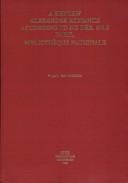
ISBN: 9004672524 9072371623 Year: 1994 Publisher: Groningen : Brill,
Abstract | Keywords | Export | Availability | Bookmark
 Loading...
Loading...Choose an application
- Reference Manager
- EndNote
- RefWorks (Direct export to RefWorks)
This book represents a critical edition of the Alexander Romance found in MS Héb. 671.5 from the Bibliothèque Nationale in Paris.
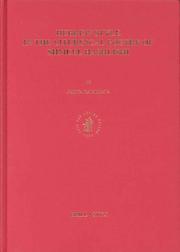
ISBN: 9789004495555 9789004131514 Year: 2003 Publisher: Leiden;Boston BRILL
Abstract | Keywords | Export | Availability | Bookmark
 Loading...
Loading...Choose an application
- Reference Manager
- EndNote
- RefWorks (Direct export to RefWorks)
Shmuel ben Hoshana, the most important Hebrew liturgical poet ( paytan ) in the final stage of the flowering of the Eretz-Israeli piyyut , came of age in the latter third of the tenth century. He was active in the academy of Eretz Israel, and reached the status of the third ("HaShlishi") in the assembly, after the gaon and the av bet din . This volume examines the Hebrew style of this paytan according to some 650 Genizah fragments, which contain elements of his wide-ranging oeuvre (orthography and phonetics, morphology, syntax, sentences, vocabulary, themes and motifs). Understanding the style of Shmuel HaShlishi is critical to our understanding of the creative activity of the paytanim of the final period of the flowering of the Eretz-Israeli piyyut. His style serves as a link between the Eretz-Israeli style of the early paytanim and the new style that would emerge in Spain.
Jewish religious poetry, Hebrew --- Piyutim --- History and criticism
Book
ISBN: 1283326906 9786613326904 9004215018 900421450X Year: 2012 Publisher: Leiden ; Boston : Brill,
Abstract | Keywords | Export | Availability | Bookmark
 Loading...
Loading...Choose an application
- Reference Manager
- EndNote
- RefWorks (Direct export to RefWorks)
The last major volume of articles devoted to the topic of prayer and poetry in the Dead Sea Scrolls comprised a collection of articles presented at a conference in the year 2000 ( Liturgical Perspectives: Prayer and Poetry in Light of the Dead Sea Scrolls ). This collection reflects the state of research in the field broadly and on specific prayers and poetic texts found among the Dead Sea Scrolls; it also offers new insights into topics on which Eileen Schuller has written extensively.
Prayer --- Jewish religious poetry, Hebrew. --- Judaism. --- Dead Sea scrolls.
Book
ISBN: 156282922X Year: 1991 Publisher: New York Hyperion
Abstract | Keywords | Export | Availability | Bookmark
 Loading...
Loading...Choose an application
- Reference Manager
- EndNote
- RefWorks (Direct export to RefWorks)
Jewish religious poetry, American --- Bible. --- History of Biblical events --- Poetry.
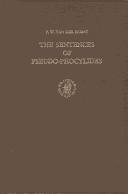
ISBN: 9004057072 9789004057074 9789004675490 Year: 1978 Volume: v. 4 Publisher: Leiden ;Boston Brill
Abstract | Keywords | Export | Availability | Bookmark
 Loading...
Loading...Choose an application
- Reference Manager
- EndNote
- RefWorks (Direct export to RefWorks)
Jewish religious poetry --- 229*235 --- Judaism --- Jewish poetry --- Jewish religious literature --- Religious poetry --- Jewish hymns --- Pseudo-Phocylides --- Theses --- Jewish religious poetry. --- 229*235 Pseudo-Phocylides
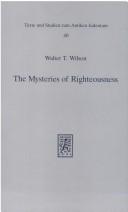
ISBN: 3161462114 9783161462115 Year: 1994 Publisher: Tübingen: Mohr,
Abstract | Keywords | Export | Availability | Bookmark
 Loading...
Loading...Choose an application
- Reference Manager
- EndNote
- RefWorks (Direct export to RefWorks)
Pseudo-Phocylides --- Jewish religious poetry --- Judaism in literature --- Pseudo-Phocylides - Admonitions
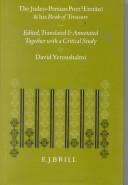
ISBN: 9789004494862 9789004103016 Year: 1995 Publisher: Leiden;Boston BRILL
Abstract | Keywords | Export | Availability | Bookmark
 Loading...
Loading...Choose an application
- Reference Manager
- EndNote
- RefWorks (Direct export to RefWorks)
In the course of their long history on Iranian soil the Jews of Iran have produced a large body of literature which has been little studied and published. This volume deals with one of the most prominent Jewish poets of Iran, known as 'Emrānī (1454-1536 C.E.). The book consists of three parts. The first part studies 'Emrānī's time, life and work and analyzes in depth the poet's last major work entitled Ganj-nāme (The Book of Treasure). Ganj-nāme , which is closely modeled after compositions of classical Persian literature, is 'Emrānī's versified commentary of the ethical tractate of the Mishnah commonly known as Pirqey Abot ("The Chapters of the Fathers"). The second part of the book offers the English translation, annotation and source study of Ganj-nāme . The third and last part of the book provides a critical edition of Ganj-nāme.
Literature --- Jewish religious poetry, Judeo-Persian --- ʻEmrānī, --- Mishnah. --- Commentaries. --- In literature.
| Listing 1 - 10 of 47 | << page >> |
Sort by
|

 Search
Search Feedback
Feedback About UniCat
About UniCat  Help
Help News
News